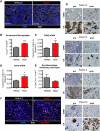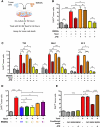Macrophages and cathepsin proteases blunt chemotherapeutic response in breast cancer
- PMID: 22156207
- PMCID: PMC3243057
- DOI: 10.1101/gad.180331.111
Macrophages and cathepsin proteases blunt chemotherapeutic response in breast cancer
Abstract
The microenvironment is known to critically modulate tumor progression, yet its role in regulating treatment response is poorly understood. Here we found increased macrophage infiltration and cathepsin protease levels in mammary tumors following paclitaxel (Taxol) chemotherapy. Cathepsin-expressing macrophages protected against Taxol-induced tumor cell death in coculture, an effect fully reversed by cathepsin inhibition and mediated partially by cathepsins B and S. Macrophages were also found to protect against tumor cell death induced by additional chemotherapeutics, specifically etoposide and doxorubicin. Combining Taxol with cathepsin inhibition in vivo significantly enhanced efficacy against primary and metastatic tumors, supporting the therapeutic relevance of this effect. Additionally incorporating continuous low-dose cyclophosphamide dramatically impaired tumor growth and metastasis and improved survival. This study highlights the importance of integrated targeting of the tumor and its microenvironment and implicates macrophages and cathepsins in blunting chemotherapeutic response.
Figures






Comment in
-
Microenvironment: Protective surroundings.Nat Rev Cancer. 2011 Dec 23;12(1):2. doi: 10.1038/nrc3196. Nat Rev Cancer. 2011. PMID: 22193399 No abstract available.
Similar articles
-
IL-4 induces cathepsin protease activity in tumor-associated macrophages to promote cancer growth and invasion.Genes Dev. 2010 Feb 1;24(3):241-55. doi: 10.1101/gad.1874010. Epub 2010 Jan 15. Genes Dev. 2010. PMID: 20080943 Free PMC article.
-
Cysteine cathepsin activity suppresses osteoclastogenesis of myeloid-derived suppressor cells in breast cancer.Oncotarget. 2015 Sep 29;6(29):27008-22. doi: 10.18632/oncotarget.4714. Oncotarget. 2015. PMID: 26308073 Free PMC article.
-
Taxol in combination with doxorubicin or etoposide. Possible antagonism in vitro.Cancer. 1993 Nov 1;72(9):2705-11. doi: 10.1002/1097-0142(19931101)72:9<2705::aid-cncr2820720930>3.0.co;2-k. Cancer. 1993. PMID: 8104682
-
Cysteine cathepsin proteases: regulators of cancer progression and therapeutic response.Nat Rev Cancer. 2015 Dec;15(12):712-29. doi: 10.1038/nrc4027. Nat Rev Cancer. 2015. PMID: 26597527 Review.
-
Leading the invasion: The role of Cathepsin S in the tumour microenvironment.Biochim Biophys Acta Mol Cell Res. 2020 Oct;1867(10):118781. doi: 10.1016/j.bbamcr.2020.118781. Epub 2020 Jun 13. Biochim Biophys Acta Mol Cell Res. 2020. PMID: 32544418 Review.
Cited by
-
Increased drug resistance in breast cancer by tumor-associated macrophages through IL-10/STAT3/bcl-2 signaling pathway.Med Oncol. 2015 Feb;32(2):352. doi: 10.1007/s12032-014-0352-6. Epub 2015 Jan 9. Med Oncol. 2015. PMID: 25572805
-
Tumor-associated macrophages promote resistance of hepatocellular carcinoma cells against sorafenib by activating CXCR2 signaling.J Biomed Sci. 2022 Nov 21;29(1):99. doi: 10.1186/s12929-022-00881-4. J Biomed Sci. 2022. PMID: 36411463 Free PMC article.
-
Direct visualization of emergent metastatic features within an ex vivo model of the tumor microenvironment.Life Sci Alliance. 2024 Oct 17;8(1):e202403053. doi: 10.26508/lsa.202403053. Print 2025 Jan. Life Sci Alliance. 2024. PMID: 39419548 Free PMC article.
-
3D Biomimetic Models to Reconstitute Tumor Microenvironment In Vitro: Spheroids, Organoids, and Tumor-on-a-Chip.Adv Healthc Mater. 2023 Jul;12(18):e2202609. doi: 10.1002/adhm.202202609. Epub 2023 Mar 29. Adv Healthc Mater. 2023. PMID: 36917657 Free PMC article. Review.
-
The dual role of tumor necrosis factor-alpha (TNF-α) in breast cancer: molecular insights and therapeutic approaches.Cell Oncol (Dordr). 2020 Feb;43(1):1-18. doi: 10.1007/s13402-019-00489-1. Epub 2020 Jan 3. Cell Oncol (Dordr). 2020. PMID: 31900901 Review.
References
-
- Bell-McGuinn KM, Garfall AL, Bogyo M, Hanahan D, Joyce JA 2007. Inhibition of cysteine cathepsin protease activity enhances chemotherapy regimens by decreasing tumor growth and invasiveness in a mouse model of multistage cancer. Cancer Res 67: 7378–7385 - PubMed
-
- Blansfield JA, Caragacianu D, Alexander HR III, Tangrea MA, Morita SY, Lorang D, Schafer P, Muller G, Stirling D, Royal RE, et al. 2008. Combining agents that target the tumor microenvironment improves the efficacy of anticancer therapy. Clin Cancer Res 14: 270–280 - PubMed
-
- Bogyo M, Verhelst S, Bellingard-Dubouchaud V, Toba S, Greenbaum D 2000. Selective targeting of lysosomal cysteine proteases with radiolabeled electrophilic substrate analogs. Chem Biol 7: 27–38 - PubMed
Publication types
MeSH terms
Substances
Grants and funding
LinkOut - more resources
Full Text Sources
Other Literature Sources
Medical
Molecular Biology Databases
